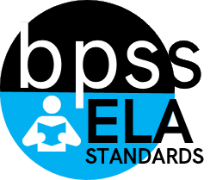ELA-09.SL.04 |
9th Grade ELA Targeted Standards
(SL) Speaking and Listening Strand
Cluster: Presentation of Knowledge and Ideas
ELA-09.SL.04 Organize, develop, and present claims, information, findings, and supporting evidence, using communication techniques appropriate to purpose, audience, and task.
|
Student Learning Targets:
Knowledge Targets
- I can define the following terms as they apply to this standard:
- Concisely -- to state in as few words as possible (does not mean simplicity).
- Development -- the examples, ideas, details, and commentary the speaker adds to ensure the ideas are thoroughly expressed.
- Findings -- conclusions drawn from observations, investigations, experiments or inquiries.
- Line of reasoning -- the speaker links a series of ideas in a meaningful and clear way; the speaker connect the dots to show how he/she arrived at his/her conclusion.
- Supporting evidence -- data, information, quotations, examples, or other information the speaker uses to support the claim.
Reasoning Targets
- I can determine what evidence I need to support my claim and develop my ideas.
- I can determine what style, format, or approach would be best to deliver my information and findings.
Skills (Performance) Targets
- I can adjust my message so it is appropriate to purpose, audience, and task.
Product Targets
- I can deliver a well-developed speech, complete with supporting evidence, that presents information in a clear, concise, and logical manner.
- I can prepare a presentation with organization, development, substance, and style appropriate to purpose, task, and audience.
|
| Rubric - Resources |
Proficiency Scale
| Measurement of Progress |
Presentation of Knowledge and Ideas:
-
SL9-10.4 Organize, develop, and present claims, information, findings, and supporting evidence, using communication techniques appropriate to purpose, audience, and task.
-
SL9-10.5 Make strategic use of digital media (e.g., textual, graphical, audio, visual, and interactive) in presentations to enhance understanding of findings, reasoning, and evidence and to add interest.
- SL9-10.6 Adapt verbal and nonverbal communication to a variety of contexts, audiences, and tasks, demonstrating fluency and poise, and a command of formal English when indicated or appropriate.
|
Sample Activity
|
| Advanced |
In addition to expectations of proficiency, student provides consistent evidence of in-depth inferences and applications that go beyond what was taught and expected.
|
- |
| Proficient |
-
The student can
-
present information clearly, concisely, and logically.
-
delivers a presentation in which organization, development, substance and style are appropriate to purpose, audience, and task.
-
strategically integrate appropriate digital media or visual aids to enhance interest and understanding.
-
employ effective verbal and nonverbal delivery techniques: eye contact, rate, volume, inflection, pronunciation, enunciation, gestures, poise, language, conversational tone.
|
- |
| Progressing |
There are no major errors or omissions regarding the simpler details and processes as the student:
-
presents information in a logical and organized manner.
-
delivers a presentation appropriate to purpose, audience, and task.
-
integrates appropriate digital media or visual aids.
-
employs some effective verbal and nonverbal delivery techniques: eye contact, rate, volume, inflection, pronunciation, enunciation, gestures, poise, language, conversational tone.
-
recognizes or recalls specific terminology that relates to speaking and listening skills, such as:
-
Digital media, rate, volume, inflection, pronunciation, enunciation, gestures, poise, language, conversational tone.
However, the student exhibits major errors or omissions regarding the more complex ideas and processes. |
- |
| Novice |
With help, a partial understanding of some of the simpler details and processes and some of the more complex ideas and processes. |
- |
Resources
Websites
Vocabulary |

